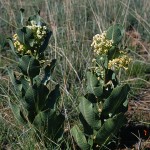Broad-leafed Milkweed, Common Milkweed
Asclepias latifolia
Asclepiadaceae
Description
More than 30 species of milkweed have been recorded in Texas. Broad-leafed Milkweed is noted for its robust nature and leaf size. SEINet’s SW Field Guide states that the plant “appears somewhat cabbage-like with its thick, rounded, dark green leaves, the leaves appearing loosely whorled around the stem and often extending upwards to surround the inflorescence of creamy white or yellowish inflorescences.” An herbaceous perennial, this plant can reach up to 31 inches or 80 cm tall and has little branching. Its nearly orbicular to broadly elliptical dark green leaves reach up to 10 cm by 5 cm and have prominent veins with undulate margins. The leaves tend to obscure the stem. They are woolly when young and hairless with maturity. The flowers are typically pale green to yellowish but hidden by the leafage. Their five petals and five sepals fold downward forming a structure of five to eight cm. Blooming occurs from May to August. Flowers give rise to two to four smooth pods erect on deflexed pedicels about seven to nine cm long from July to October. The pod’s seeds typically have very silky tan hairs.Habitat
Broad-leafed Milkweed is most common along trails and roadsides, less so in pastures. As with many weeds of low palatability, this species increases in heavily grazed pastures. It is frequent to abundant over much of the Trans-Pecos, the High Plains, Rolling Plains, and the western Edwards Plateau of Texas. It is found from Nebraska to Utah and west to Arizona.Toxic Agent
This plant poisons cattle and goats, but more often sheep. The toxic agents are cardiac glycosides. To be poisoned, cattle can eat as little as 1.0 percent of their body weight in Broad-leafed Milkweed; amounts as low as 0.15 percent have poisoned sheep and goats. Broad-leafed Milkweed is toxic in all growth stages, but it is most toxic when immature. Cattle can generally graze frost-killed plants and not be poisoned.Signs of Livestock Ingestion
The signs produced by most species of Asclepias differ only in degree. The first signs include profound depression, weakness and staggering, and collapse. Followed by frequent, intermittent muscular tremors; Labored respiration, elevated temperature, and pupil dilation; Death, after a comatose period of variable duration. Signs appear within a few hours of ingestion of a toxic dose, and death follows within a few days in most fatal cases.Management Strategies
The best way to prevent losses from Broad-leafed Milkweed is to maintain good range condition. Removing plants along trails and in holding traps may prevent many losses, especially when hungry livestock are being trailed. Avoid placing animals where infestations are severe, and forage is limited. Do not feed hay contaminated with milkweed. Although no medicinal treatment is specified, sedatives, laxatives, and intravenous fluids may help.Images
Plant Characteristics
Flower Color: Cream, Green, Yellow
Seed Type: Bean/Pod
Duration: Perennial
Stem Texture: Hairless/Smooth
Growth Habit: Forbs/Broadleaf
Leaf Shape
 : Simple with Pinnate or Parallel Venation
: Simple with Pinnate or Parallel Venation
Season: Warm
Distribution
 : 03 - Post Oak Savannah, 07 - Edwards Plateau, 08 - Rolling Plains, 09 - High Plains, 10 - Trans-Pecos
: 03 - Post Oak Savannah, 07 - Edwards Plateau, 08 - Rolling Plains, 09 - High Plains, 10 - Trans-Pecos
Distributions
Distribution refers to the ecological region in Texas that a plant has been found. You can also view a clickable map.
Book: Toxic Plants of Texas (B-6105)
Collection: Toxics, Wild Flowers
Livestock Affected: Cattle, Goats, Horses, Sheep
Livestock Signs: Abnormal Heartbeat, Collapse, Coma, Convulsions, Depression/ Weakness, Dilated Pupils, Excess Salivation, Incoordination, Irregular Breathing




